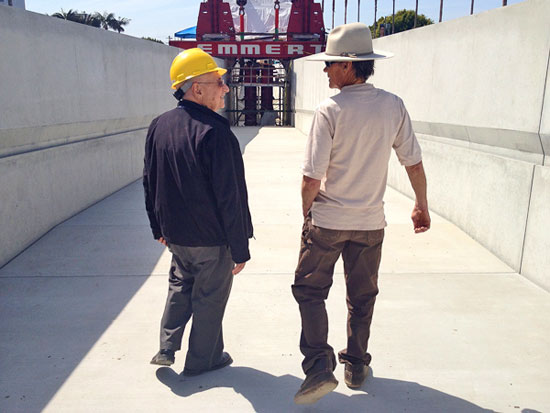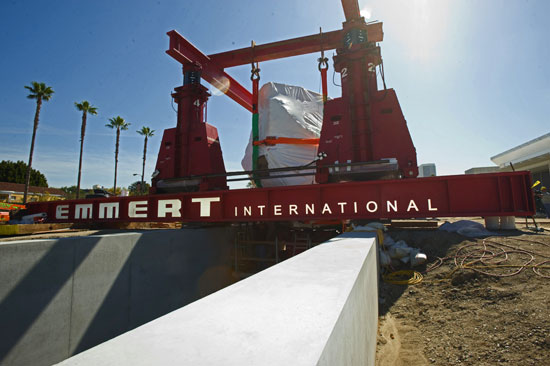The artist and the rock
April 19, 2012

Michael Heizer, right, gives architect Frank Gehry a sneak peek at “Levitated Mass,” which the artist has been quietly assembling at LACMA. Photo/Michael Govan
When we last left The Rock, it was rolling into the Los Angeles County Museum of Art at the end of an internationally televised odyssey. This week, behind cloaked chain-link fences, the two-story-high boulder crossed a much less public milestone: Under the direction of Nevada earth artist Michael Heizer, it was lowered, inch by inch, onto a long concrete trench behind the museum, taking its place in “Levitated Mass,” Heizer’s new masterpiece.
The roar that accompanied Tuesday’s “touchdown,” as crewmembers called it, was not of applause but of heavy equipment. As LACMA Director Michael Govan watched from the sidelines, dust gathering on his dark blue dress suit, the 67-year-old Heizer issued orders from inside the trench, squinting behind sunglasses in a yellow hardhat. Overhead, the boulder dangled from a massive red gantry crane.
“Whoa, whoa, whoa!” the crew cautioned as the 340-ton boulder met the 456-foot-long slot and settled into position. A layer of high-density grout squeezed out across the steel plates that secure the rock to its cradle. Finally—after a flurry of testing, adjusting and grout-scraping—the artist, renowned for precision, relaxed slightly.
“It landed perfect,” he declared to Govan, observing that the rock hit the grout “exactly as it was intended.” Then, not missing a beat, Heizer turned to one of the seven engineers on the project to discuss the myriad ways in which the sculpture is being seismically secured.
The artwork’s assembly this week offered a rare glimpse of the famously publicity-averse artist with the creation that generated a Southern California spectacle earlier this year. For 11 nights in February and March, the granite boulder was a local celebrity as it moved 105 miles on surface streets from a Jurupa Valley quarry to the backyard at LACMA.
While Southern California cheered, partied, made marriage proposals and otherwise marveled at the raw material for Heizer’s project, the artist himself kept his distance—no TV interviews, no press calls, not even a cameo appearance at the boulder’s March 10 grand entrance at LACMA.
Late last month, however, Heizer quietly arrived from his remote compound in the Nevada desert, where he has been working for the past four decades on “City,” a vast, Stonehenge-scaled project near Area 51, the secret military installation.
Since then, he’s been living with his wife and dog in an Airstream trailer on the LACMA campus, just a stone’s throw from his artwork, which will allow visitors to walk down the trench and under the boulder, positioned 15 feet overhead. Heizer’s expected to return to Nevada later this week
On Monday, as TV crews arrived to witness the artwork’s progress at LACMA’s invitation, Heizer remained in the Airstream. But on Tuesday, with the media gone, the artist emerged up close and personal with his creation, fine-tuning its support system, measuring its angles, even lying down flat on the bare earth to peer into its crevices to make sure no telltale signs of connection were showing.
“You’ve got to get this dug out,” he called to one worker, pointing to a smudge of grout along the rock’s edge. “Can we get a piece of plywood?” he called to another. “If I had something that was taking a load here, it would be better,” he instructed an engineer, studying the rock’s corner. “If you can make that load-bearing, I think that’s the 3,500-year plan that we’re looking for.”
Between conferences, Heizer chatted with Govan about Keith Heyer Meldahl’s “Rough Hewn Land,” a book on the geology of the West that Govan had given to the artist. (Among other things, the book argues that, when it comes to the Big One, the San Andreas fault is far less dangerous than the faults near Salt Lake City.)
Mostly, however, the artist was all business. As for Govan, his reaction to the rock’s successful placement was “incredible relief.”
“There was so much discussion of the stress up to this point,” said the museum director. “Would it land correctly? They had been shaving the bottom of the rock, they’d been talking about the grout. Then, as Mike said, it pretty much landed perfectly, just as he’d planned—but after a month of intense discussion.”
Seismic engineering will continue this week as the rock is permanently affixed to the steel shelves. Besides the high-density grout, the rock is being drilled with nine holes that will be injected with high-strength epoxy, followed by the insertion of 1-inch diameter pins that will keep it from lifting or rolling in an earthquake. Then five steel “wedges” will be placed around the rock to prevent side-to-side sliding.
After that, Govan says, “the rest is cosmetics,” as a desert-scape is installed around the sculpture. The museum director hopes to open “Levitated Mass” to the public in mid-June.

This week at LACMA, the rock finally was attached to a concrete channel to form "Levitated Mass," which the museum hopes to open in June.
Posted 4/19/12












 405 bridge work causes a stink
405 bridge work causes a stink





